The Samsung 950 Pro PCIe SSD Review (256GB and 512GB)
by Billy Tallis on October 22, 2015 10:55 AM ESTSequential Write Performance
The sequential write test isn't limited to a small span of the disk, as that usually doesn't make a difference for this performance metric. As always, our averages are of the lower queue depths, but scaling to higher queue depths is also investigated. Bulk file copies and recording uncompressed video are the kind of uses that depend on sequential write performance.
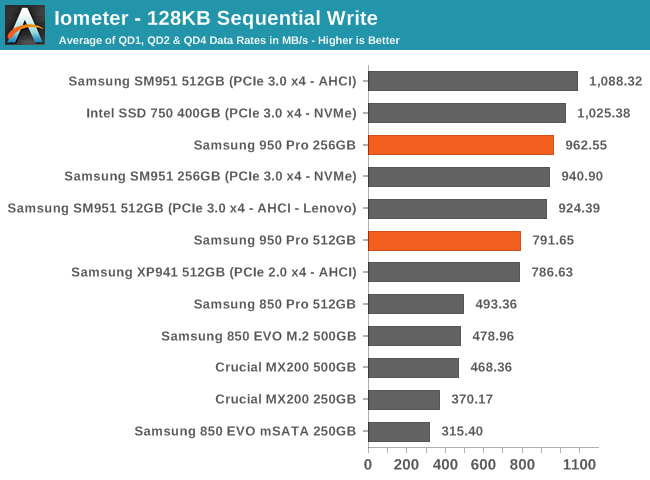
Even at low queue depths, most SSDs can spread a sequential write workload across multiple channels to achieve very high throughput. All of the PCIe drives perform well above the SATA limit but nowhere near the capacity of the PCIe links. The 512GB 950 Pro seems to again be encountering thermal throttling, and more severely than the SM951s we tested.
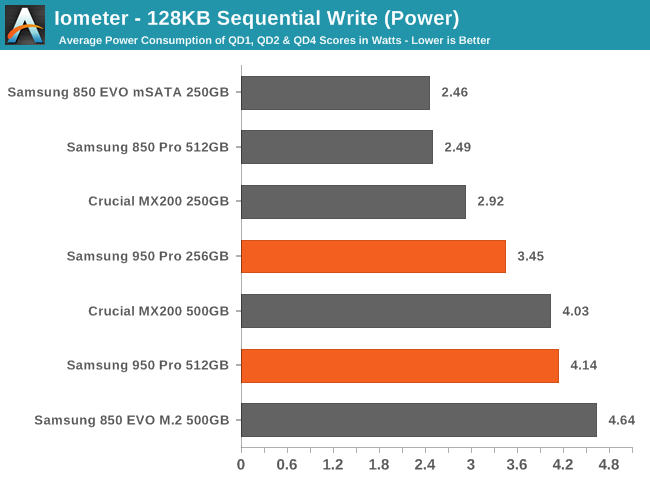
The average power consumption for writes is still on the high side by SATA standards, but is quite reasonable in light of the performance achieved.
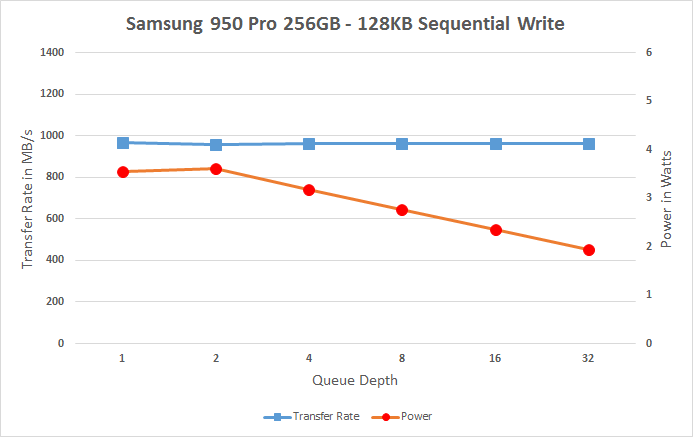 |
|||||||||
Performance across the sequential write test is mostly constant, but power isn't. The declines in power consumption in spite of increased queue depth are again most likely an artifact of whatever background processing is going on in the drive. On SATA drives, it's usually obvious from looking at the power meter when a drive has completed background processing and is truly idle and ready to run the next test, but with the lack of working power management for PCIe drives on our testbed I'm not so sure here. Overall it's probably a good sign that the drives were able to maintain high performance in spite of whatever else was going on, but given more cooling the 512GB can probably do much better.
Sequential Read Performance
Just like the random read test, sequential reads are tested across the span of a full drive and a representative sample of queue depths. Most operations involving large files (typically images and videos) fall under this test's purveiw, but streaming or playing even the highest resolution videos won't be a challenge for any of these drives. Copying files to another SSD or loading a new level in a video game would be more likely to show noticeable difference from better performance here.
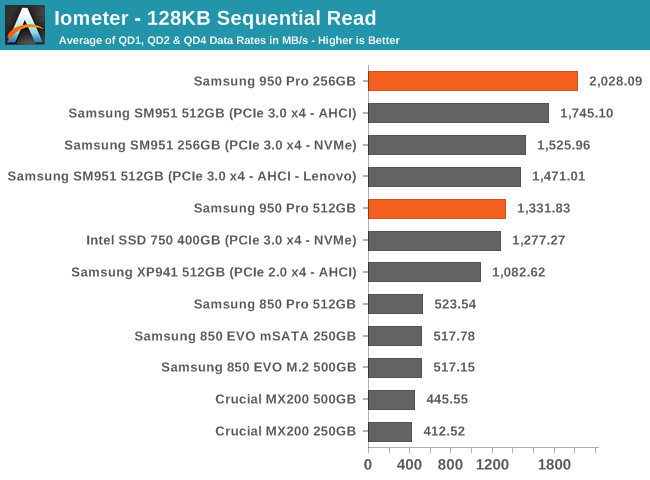
The sequential read performance is probably the best showcase of what the PCIe 3.0 x4 interface can do. The 256GB 950 Pro attains over half of the link speed, but the 512GB is again bogged down by something—relatively speaking, since it's still more than twice the speed of SATA and faster than even the Intel SSD 750. It's possible that the 950 Pro isn't faithfully implementing the secure form of the NVMe format command and some lingering fragmentation is preventing the 512GB drive from performing as specified. Read operations require less power to be supplied to the flash chip than for writes, but if the thermal throttling is all in the controller it could be showing up here as well.
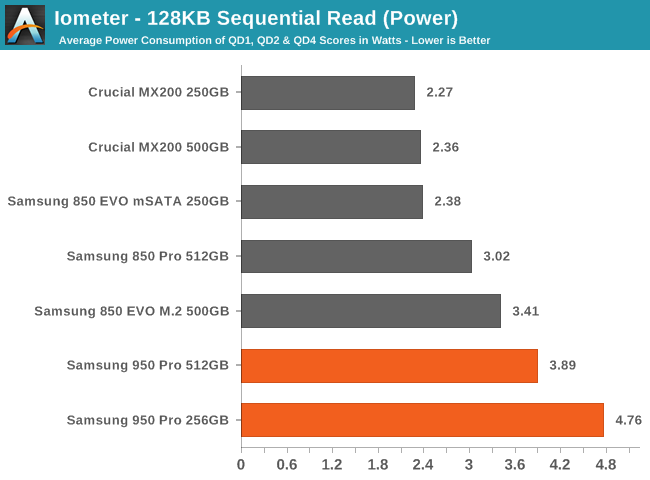
Relative to each other, the 950 Pro's power consumption is in line with the performance they're demonstrating, and proportionally much better than the SATA drives.
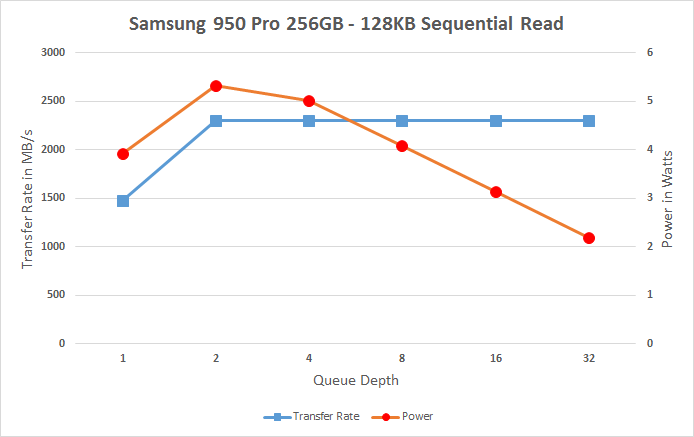 |
|||||||||
At queue depth 1, both of the 950 drives are performing similarly. When moving to higher queue depths the 256GB immediately hits 104% of its rated speed, but the 512GB doesn't improve any. (It's worth noting the differing scale for Transfer Rate in the graphs above.) The puzzling decline in power consumption at higher queue depths shows up again on the 256GB and definitely warrants deeper investigation.










142 Comments
View All Comments
AntDX316 - Thursday, November 12, 2015 - link
we need REAL-WORLD performance than synthetic benchmarksthis is like how it is with DDR speeds but they do absolutely like nothing even though bandwidth is like 10x in spread difference
SmashingTool - Thursday, October 22, 2015 - link
" and in order to boot from an NVMe drive your motherborad's firmware needs NVMe support."^ Typo
Ian Cutress - Thursday, October 22, 2015 - link
Fixed! Thanks :)todlerix - Thursday, October 22, 2015 - link
How fast does the system boot with the 950 pros? I read the NVMe slows boot times down by a huge amount.Rajinder Gill - Thursday, October 22, 2015 - link
Considering most people only the system once per day, the wait should not be considered an issue. If one BOOTs the machine many times per day, S3 sleep is a quick way back to the desktop.Rajinder Gill - Thursday, October 22, 2015 - link
*Considering most people only BOOT the system once per day, the wait should not be considered an issue.bji - Thursday, October 22, 2015 - link
Even if I only boot my computer once per day, the time spent waiting for it to boot is annoying and I consider boot times important for that reason. When there is little other user-perceivable difference in SSD drives, a boot that happens 3 or 4 seconds faster is a significant factor.Makaveli - Thursday, October 22, 2015 - link
You know whats equally annoying people that sit and stare at boot screens lol.Go get a bagel, take a piss do something crying over 10 seconds isn't exactly productive.
Rajinder Gill - Thursday, October 22, 2015 - link
This is called being enthusiastic about the wrong thing. If getting to the desktop matters that much to one's productivity, then using S3 resume would be the "logical" thing to do.Rajinder Gill - Thursday, October 22, 2015 - link
Shame on me for making a rational argument to irrational minds... ;)